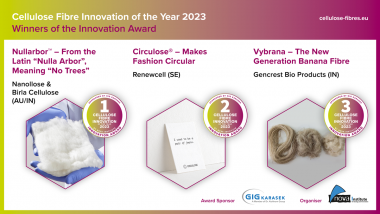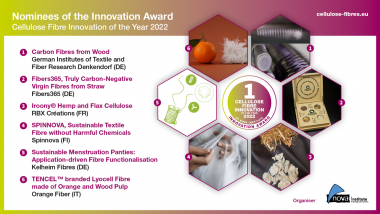Bacteria instead of trees, textile and agricultural waste
For the third time, the nova-Institut awarded the "Cellulose Fibre Innovation of the Year" prize at the "Cellulose Fibres Conference 2023" in Cologne, 8-9 March 2023.
The yearly conference is a unique meeting point of the global cellulose fibres industry. 42 speakers from twelve countries highlighted the innovation potential of cellulosic fibres and presented the latest market insights and trends to more than 220 participants from 30 countries.
Leading international experts introduced new technologies for recycling of cellulose rich raw materials and practices for circular economy in textiles, packing and hygiene, which were discussed in seven panel discussion with active audience participation.
Prior to the conference, the conference advisory board had nominated six remarkable innovations. The winners were elected in an exciting head-to-head live-voting by the conference audience on the first day of the event.
The collaboration between Nanollose (AU) and Birla Cellulose (IN) with tree-free lyocell from bacterial cellulose called Nullarbor™ is the winning cellulose fibre innovation 2023, followed by Renewcell (SE) cellulose fibres made from 100 % textile waste, while Vybrana – the new generation banana fibre from Gencrest Bio Products (IN) won third place.
Winner: Nullarbor™ – Nanollose and Birla Cellulose (AU/IN)
In 2020, Nanollose and Birla Cellulose started a journey to develop and commercialize treefree lyocell from bacterial cellulose, called Nullarbor™. The name derives from the Latin “nulla arbor” which means “no trees”. Initial lab research at both ends led to the joint patent application “production of high-tenacity lyocell fibres made from bacterial cellulose”.
Nullarbor is significantly stronger than lyocell made from wood-based pulp; even adding small amounts of bacterial cellulose to wood pulp increases the fibre toughness. In 2022, the first pilot batch of 260 kg was produced with 20 % bacterial pulp share. Several high-quality fabrics and garments were produced with this fibre. The collaboration between Nanollose and Birla Cellulose now focuses on increasing the production scale and amount of bacterial pulp in the fibre.
Second place: Circulose® – makes fashion circular – Renewcell (SE)
Circulose® made by Renewcell is a branded dissolving pulp made from 100 % textile waste, like worn-out clothes and production scraps. It provides a unique material for fashion that is 100 % recycled, recyclable, biodegradable, and of virgin-equivalent quality. It is used by fibre producers to make staple fibre or filaments like viscose, lyocell, modal, acetate or other types of man-made cellulosic fibres. In 2022, Renewcell, opened the world’s first textile-to-textile
chemical recycling plant in Sundsvall, Sweden – Renewcell 1. The plant is expected to reach an annual capacity of 120,000 tonnes.
Third place: Vybrana – The new generation banana fibre – Gencrest Bio Products (IN)
Vybrana is a Gencrest’s Sustainable Cellulosic Fibre upcycled from agrowaste. Raw fibres are extracted from the banana stem at the end of the plant lifecycle. The biomass waste is then treated by the Gencrest patented Fiberzyme technology. Here, cocktail enzyme formulations remove the high lignin content and other impurities and help fibre fibrillation. The company's proprietary cottonisation process provides fine, spinnable cellulose staple fibres suitable for blending with other staple fibres and can be spun on any conventional spinning systems giving yarns sustainable apparel. Vybrana is produced without the use of heavy chemicals and minimized water consumption and in a waste-free process where balance biomass is converted to bio stimulants Agrosatva and bio-based fertilizers and organic manure.
nova-Institut GmbH cellulosic fiber Cellulose Fibre Innovation of the Year Cellulose Fibre Innovation
nova-Institut GmbH / Textination



